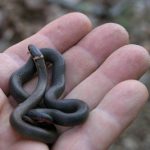
Several species of snakes hatch or are born in the late summer and early fall, and we’ve received numerous calls and emails requesting snake identification. Most Georgia snakes are non-venomous, beneficial, and protected by law. The exceptions for our area are copperheads, timber rattlers (also called canebrake rattlers), and pygmy rattlers. Rat snakes, garter snakes, ringneck, and crowned snakes are among the many beneficial species that eat rodents, termites, and other pests. Although most snakes are not aggressive, they may strike if startled or threatened. As we move about our landscapes doing fall cleaning and planting, we should make noise and use caution before reaching into areas that have been undisturbed for a while. Covered woodpiles and remote corners of storage sheds could be nesting places for snakes (and spiders).